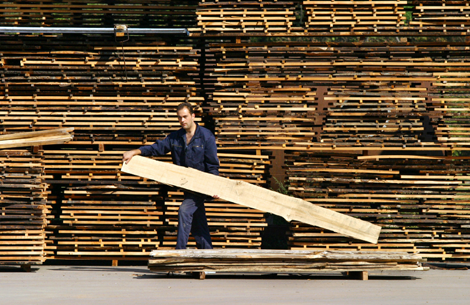
For proof that the Softwood Lumber Agreement is bad for British Columbia, look no further than what is absent from the list of forest products covered under the deal, namely, raw, unprocessed logs.
By excluding logs from the list and shielding them from export caps and taxes, the deal opens the door to a ramp-up in log exports from B.C. in the months and years ahead.
That is not good news for regions of the province along the coast where mill closures and already high levels of log exports have left many communities reeling. Nor may it be welcome in the Interior where there are proposals floating about to export massive numbers of raw logs from beetle-attacked pine trees to markets such as China.
Making matters potentially even worse, for forestry workers and rural communities alike, are other terms of the agreement that penalize lumber and value-added mills once export levels or prices hit certain benchmarks. Process a log into lumber under the SLA and you pay taxes. Move into secondary manufacturing, employ more people re-cutting lumber into higher value boards, and pay higher taxes still.
So on the one hand, the SLA has a built-in incentive to ship out a crude raw product and on the other hand it has built-in disincentives as far as adding value to logs here in B.C. is concerned.
From a progressive, social policy perspective, the SLA -- and a number of related forest policies the B.C. government enacted in a failed bid to appease the seemingly unappeasable U.S. softwood lumber lobby -- are a disaster.
And the question we ought to ask ourselves is what our government should do about it.
Stop pandering to U.S. interests
Well, for starters, it needs to fully embrace a value-driven strategy for the forest industry. And it needs to use powers at its disposal -- timber pricing, tax incentives and allocating forest resources -- to make that happen.
As mentioned earlier, it is not just the SLA that will harm workers and communities in the years ahead, but forest policies that the provincial government enacted over the past five years and that were designed to appease the U.S. lumber lobby. Those policy changes:
- Scrapped the awarding of public timber directly to value-added companies.
- Did away with stringent no-waste provisions governing logging in the province.
- Ended the sale of timber to small, independent mills.
- Broke (seemingly) the long-standing social contract that required forest companies to operate mills in specific communities in exchange for exclusive rights to log public forestlands.
The ostensible aim of these and other "market-based reforms" was to create an open market for logs in B.C. by lifting restrictions on who could bid on allotments of public timber and to put the forest industry on a more "commercial" footing.
The province then set out to expand the volume of wood sold under auction by "taking away" some timber previously allocated under long-term renewable licence agreements to various forest companies. It then compensated the affected companies to the tune of $200 million, for wood that they "lost" and that would now be available to any interested party to bid on through auction.
The words "taken away" and "lost" appear in quotations because it is doubtful whether the companies actually lost anything. For one, substantial logging increases in the Interior in the past few years far outstrip what the province took back from the companies. For another, those companies losing wood were free to reacquire it through auctions, which is precisely what they have been doing with a tremendous amount of success ever since.
It is difficult to see how it could be otherwise. One company -- Western Forest Products -- controls one out of every two logs coming off of public forestlands on the Coast. In the Interior, three companies – Canfor, West Fraser and Tolko -- own the lion's share of logging rights. And all four companies control the bulk of B.C.'s lumber production.
Consequently, we don't have a fully functioning marketplace in the province. The great majority of value-added companies and smaller independent mills lack their own secured timber supplies. Yet they are forced increasingly to compete in a market dominated by large companies, with deep pockets and an assured supply of millions of cubic metres of timber under long-term, renewable forest tenure agreements. Unless the province takes the highly unlikely step of taking all the timber allocated under long-term forest tenures away from established interests and auctions it, value-added manufacturers and independent sawmills will require assistance in order to succeed. And that assistance will, in all likelihood, have to come from government.
Start creating incentives to create jobs
One constructive thing that the province could do right now to stimulate more secondary forest product manufacturing in B.C. is implement a new stumpage and taxation regime. Under such a scenario, payments to government would be high on items such as logs, but progressively lower as more value was added to forest products. For example, commodity lumber would generate a lower tax bill than a log, a wooden truss would generate a lower tax bill than lumber, and a wooden door would generate a lower tax bill than a truss. This would provide a powerful incentive to add further value to forest products here in B.C. And if the government got really creative, it could allow lumber makers to defer paying taxes on products that they sold to domestic re-manufacturers. When the resulting higher value product was made, the lumber maker and the re-manufacturer would split the lower tax bill.
And while on the subject of tax incentives, the government needs to consider what carrots and sticks it will yield to ensure the rampant and egregious wasting of usable logs is brought to an end in B.C. It is simply unconscionable, as earlier noted by The Tyee, to allow 3.5 million cubic metres of usable raw logs to litter logging sites in a single year in the province when they could have been used to put 3,500 people to work.
Another way for the government to stimulate more value-added manufacturing is to drop the ruse that its timber auctions are open and get back to the business of awarding allotments of timber directly to higher-value producers. Some will argue that the province can no longer do this because it has scrapped "appurtenant" mill provisions, whereby companies are required to maintain mills in specific communities in exchange for long-term access to timber on public forestlands.
But the reality is that the government has not completely abandoned this concept. In fact, in a previous article in The Tyee it was shown how the recent awarding of a long-term forest tenure to Ainsworth Lumber was linked by the province to that company building a new Oriented Strand Board (OSB) mill.
Furthermore, there are all kinds of higher value forest products that, under the terms of the SLA, are not subject to export caps or taxes. These products include wood trusses, I-Joist beams, pallets, garage doors, edge-glued products and finished window and doorframes. All of these items are higher value products that would provide badly needed jobs here in B.C. and that would help elevate the province from its present and sorry position. B.C. remains a jurisdiction that performs extremely poorly when it comes to capturing optimum value from its forest resources. We generate only about a third of a dollar in higher value products for each dollar's worth of lumber we produce, while forest industry workers in Ontario and Quebec turn out $1.50 in value-added products for each dollar's worth of lumber.
A chance for rural renewal
It is long overdue for the provincial government to figure out how to stimulate more value-added manufacturing in B.C. And one of the most powerful tools at its disposal is the direct awarding of timber to companies that make higher value products.
Workable solutions in the face of the Softwood Lumber Agreement are at hand. The question must be asked: will they be pursued?
If they are, we may see a resurgent rural economy.
If they are not, the future may well be one in which we witness a mass exodus of raw logs from the province, more mothballed mills and a gutted rural economy. ![]()
















Tyee Commenting Guidelines
Comments that violate guidelines risk being deleted, and violations may result in a temporary or permanent user ban. Maintain the spirit of good conversation to stay in the discussion.
*Please note The Tyee is not a forum for spreading misinformation about COVID-19, denying its existence or minimizing its risk to public health.
Do:
Do not: